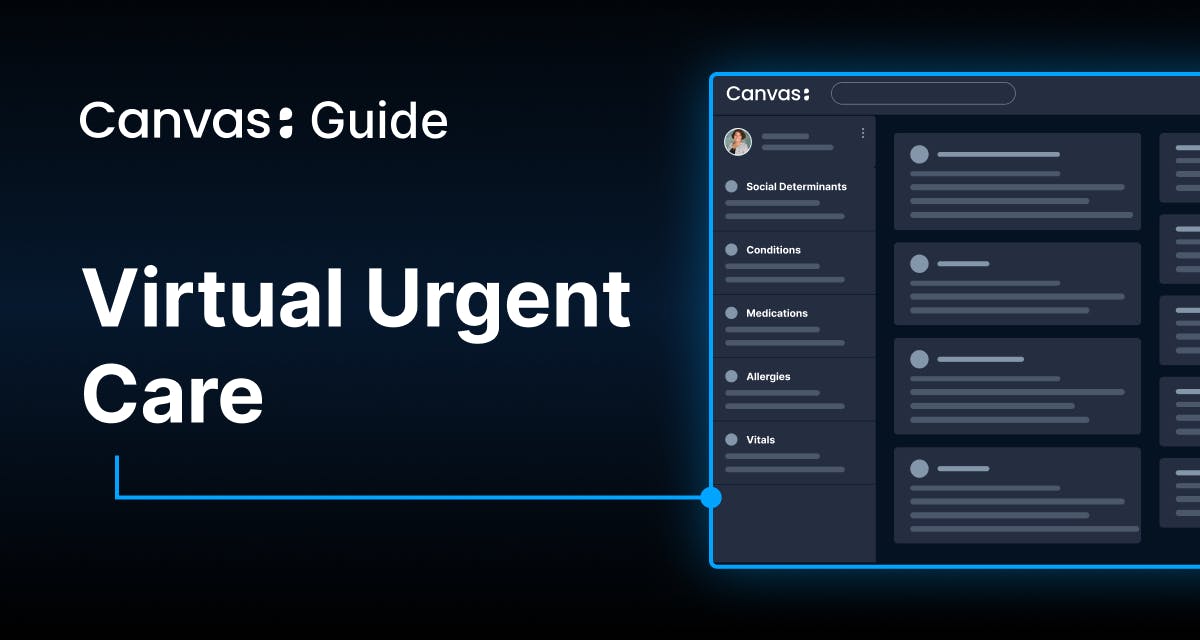At Canvas, our mission is to give care teams superpowers with software. We've built an open, extensible platform that advances a future where patients have improved access to high-quality, proactive urgent care telehealth services.
Canvas isn't just another EMR—it's a clinical operating system designed specifically for the complexities of modern healthcare delivery, including the immediate, accessible, and technology-driven care that urgent care telehealth demands.
What is Urgent Care?
Urgent care provides immediate medical attention for non-emergency conditions that require prompt treatment but don't necessitate an emergency room visit.
This accessible care model bridges the gap between primary care and emergency services, offering extended hours and walk-in availability. Urgent care addresses common acute conditions including respiratory infections, minor injuries, gastrointestinal issues, urinary tract infections, and skin conditions.
With telehealth evolution, virtual urgent care has expanded access, enabling patients to receive remote care for many conditions while maintaining clinical expertise for acute symptom management.
Key Activities in an Urgent Care Clinic
Clinical Workflows begin with patient arrival and registration, whether walk-in or scheduled online. Providers conduct rapid assessments for common urgent conditions like respiratory infections, minor injuries, and skin problems. Care decisions involve symptom evaluation, ordering necessary tests, prescribing medications, and making specialist referrals when needed, with clear protocols for escalating emergency situations.
Documentation & Care Coordination captures patient information for billing and quality tracking while accommodating different payment arrangements. Care teams—including physicians, nurse practitioners, coordinators, and triage staff—work together to manage patient transitions between virtual and in-person care, coordinate follow-up appointments, and ensure patients understand their treatment plans.
Operational Workflows handle insurance verification and appointment scheduling while supporting patient communication across phone, messaging, and video platforms. To maintain consistent care quality, practices develop clinical templates and educational resources, supported by decision support tools that help providers follow evidence-based protocols and track patient outcomes.
Telehealth Integration includes verifying patients can access video visits, conducting virtual examinations, and coordinating remote monitoring when appropriate. Systems automatically flag cases needing urgent in-person care. Licensing across multiple states allows broader patient access to virtual services.
Urgent Care in Telehealth Landscape in 2025
The urgent care telehealth market is experiencing unprecedented growth, with significant opportunities and challenges shaping the industry:
Market Growth Indicators:
- Sector experiencing rapid expansion with telehealth adoption fueling growth
- Growing patient volumes and increasing service complexity
- Rising revenue per visit reflecting expanded service offerings
- Healthcare executives prioritizing revenue growth while balancing affordability
Patient Preferences and Adoption:
- Majority of patients prefer hybrid care models combining virtual and in-person care
- Increasing demand for same-day access and convenience
- Technology adoption accelerating across demographics
- Growing acceptance of telehealth for urgent care needs
However, the industry faces significant regulatory uncertainty. Many Medicare telehealth flexibilities that enabled rapid expansion during the pandemic are set to expire on September 30, 2025, creating a "telehealth policy cliff" that threatens to disrupt established virtual care programs.
Canvas: Modern EMR Platform for Virtual Urgent Care Innovation
Canvas delivers all the core functionality you need to run your virtual urgent care practice, but with a fundamental difference: everything is built on a unified architecture that makes virtual urgent care seamless rather than an afterthought.
You can see these capabilities in action and trial a prebuilt Canvas EMR optimized for Virtual Urgent Care here.
Core Platform Capabilities for Urgent Care
Canvas provides flexible, structured charting that supports rapid urgent care encounters and virtual care delivery. Our signature Narrative Charting experience feels natural to clinicians while capturing structured data that powers real-time clinical decision support and automation. Hyperscribe, Canvas's clinical copilot, further enhances telehealth documentation by working in real-time with full patient context to capture structured information, suggest care actions, and automate routine documentation tasks—all while maintaining clinical accuracy and provider control during virtual encounters.

How Canvas Transforms Urgent Care in Telehealth
Virtual urgent care requires a fundamentally different approach than episodic in-person care. Canvas is designed from the ground up to support the immediate, accessible, and technology-driven approach that delivers better outcomes for patients seeking rapid care for non-emergency conditions.
Intelligent Patient Access and Preparation
Canvas supports multiple virtual urgent care access models through automated scheduling protocols that respond to patient demand patterns and provider availability:
Smart Scheduling Features:
- Dynamic same-day appointment creation triggered by symptom severity algorithms
- 24/7 automated triage with continuous patient routing
- Real-time availability optimization based on provider expertise
- Hybrid care coordination bridging virtual and in-person visits
Adaptive Patient Preparation employs intelligent workflows that automatically customize based on appointment type and patient history:
- Pre-visit forms dynamically assigned based on presenting symptoms
- Technology readiness protocols that verify patient capabilities
- Insurance verification workflows triggered automatically upon booking
- Condition-specific questionnaires adapting to chief complaints
Documentation and Clinical Decision Support
Healthcare organizations struggle with inefficient appointment documentation workflows, which adds significant expenses to operations. Canvas addresses this through intelligent automation powered by event-driven protocols that respond to clinical changes in real-time.
Documentation Automation:
- Assessment templates populate instantly when symptoms are documented
- Patient history and previous treatments auto-surface during encounters
- Follow-up tasks generate automatically without manual intervention
- Structured data capture supports billing and quality metrics
Dynamic Documentation Templates provide condition-responsive templates that automatically populate and adapt based on patient data and clinical context. When specific symptoms are detected, templates streamline the path from symptom presentation to treatment decision.
Real-Time Clinical Decision Support provides automated guidance tailored to urgent care:
- Appropriateness Screening: Automated assessment of telehealth vs. in-person care suitability
- Differential Diagnosis Support: Evidence-based diagnostic assistance for common presentations
- Treatment Protocol Guidance: Automated recommendations with prescription suggestions
- Escalation Protocols: Clear triggers for emergency services or urgent in-person evaluation
Seamless Care Coordination and Integration
With 82% of patients preferring hybrid care models³, Canvas enables seamless transitions between virtual and in-person care through programmable workflows that automatically coordinate care across modalities⁸.
Automated Medication Management:
- Real-time prescription creation triggered by diagnostic algorithms
- Pharmacy routing automation considering patient preferences and insurance
- Drug interaction monitoring with automatic alerts and alternatives
- Medication history integration surfacing relevant patient data
Hybrid Care Model Support leverages the platform's 650+ clinical and operational events⁹ to ensure seamless care transitions:
- Appointment booking triggers automatically when in-person follow-up is needed
- Provider notifications and patient communication maintain workflow continuity
- Care summary automation generates comprehensive transition documents
- Patient education delivery provides condition-specific resources automatically
Multi-Platform Coordination integrates with essential urgent care tools:
- Video conferencing platforms for seamless clinical encounters
- Pharmacy networks for real-time prescription processing
- Laboratory services for follow-up testing coordination
- Specialist referral networks for escalated care
Advanced Workflow Customization
Canvas makes it simple to tailor your EMR to support specific urgent care needs without requiring technical expertise.
Pre-Configured Visit Types designed for common urgent care telehealth encounters:
- UTI Management Visit: Automated symptom assessment, urinalysis coordination, antibiotic protocols
- Respiratory Assessment Visit: COVID-19 screening workflows, differential diagnosis support
- Skin Condition Evaluation: Visual assessment tools, photo documentation, topical medications
- Follow-up Care Visit: Post-acute monitoring, medication adjustments, care plan updates
Quality Metrics and Performance Monitoring develops comprehensive quality assurance systems:
- Real-time Performance Dashboards: Track time-to-provider, diagnostic accuracy, patient satisfaction
- Automated Quality Improvement: Identify care delivery patterns and optimization opportunities
- Clinical Outcome Tracking: Monitor patient outcomes and enhancement opportunities
- Administrative Automation: Insurance verification, appointment reminders, post-visit surveys
Case Study: Complete Virtual Care Journey
This case study examines two virtual urgent care encounters, showcasing how Canvas's intelligent workflows enhance clinical decision-making and streamline patient care delivery.
UTI Consultation: 34-Year-Old Marketing Professional
Patient Presentation The patient connects for a same-day telehealth visit reporting burning urination, frequency, and urgency that started yesterday. She has a history of recurrent UTIs and needs care before an important presentation at work.
Canvas Workflow in Action As the provider opens the patient's chart, Canvas automatically recognizes the chief complaint and surfaces the UTI assessment template. The template pre-populates with the patient's UTI history, previous antibiotic responses, and current medications from her comprehensive medical record.
Real-Time Clinical Decision Support During the conversation, the provider documents the patient's symptoms in the narrative charting system. Canvas's clinical protocols automatically:
- Calculate UTI probability based on symptom patterns and patient history
- Surface antibiotic options based on previous cultures and resistance patterns
- Alert to potential drug interactions with the patient's current birth control medication
- Generate urinalysis order with preferred lab locations near the patient's workplace
Streamlined Care Coordination The provider confirms the treatment plan, and Canvas instantly:
- Sends the antibiotic prescription to the patient's preferred pharmacy
- Schedules a follow-up telehealth check-in for 48 hours if symptoms persist
- Provides automated patient education about UTI prevention and symptom monitoring
- Documents the encounter with structured data that supports quality metrics
Clinical Outcome: The patient receives her prescription within 30 minutes and reports symptom resolution at the automated follow-up check-in 5 days later.
Respiratory Assessment: 28-Year-Old Construction Worker
Patient Presentation The patient joins the telehealth visit reporting sore throat, mild fever, and fatigue for 3 days. He's concerned about strep throat and needs clearance to return to his physically demanding job.
Intelligent Template Activation Canvas recognizes the respiratory symptoms and automatically loads the respiratory assessment template, integrating:
- COVID-19 screening questions based on current epidemiological data
- Strep throat risk stratification protocols
- Seasonal illness probability algorithms
Dynamic Clinical Assessment As the provider conducts the virtual examination, documenting throat appearance and symptom severity, Canvas protocols automatically:
- Assess strep probability using clinical prediction rules
- Recommend rapid strep testing at a nearby urgent care location
- Suggest symptomatic treatment options while awaiting test results
- Calculate return-to-work timeline based on symptom resolution patterns
Seamless Care Transition The provider determines in-person strep testing is indicated. Canvas immediately:
- Schedules the patient at the nearest affiliated urgent care location within 2 hours
- Pre-populates the in-person provider with telehealth findings and assessment
- Sets up automated results notification when strep test completes
- Creates follow-up protocols based on positive vs. negative results
Clinical Outcome: The patient receives rapid strep testing, tests positive, starts antibiotics, and returns to work safely after appropriate treatment duration
The Impact: Better Outcomes for Everyone
For Providers: Intelligence That Accelerates Care
Canvas doesn't just document visits—it actively streamlines urgent care delivery.
Key Benefits:
- UTI templates surface automatically when symptoms are mentioned
- Drug interactions appear instantly during prescribing
- Lab locations populate based on patient geography
- Documentation, coordination, and follow-up happen automatically
For Patients: Fast, Coordinated Access
Patients experience urgent care that feels immediate and well-orchestrated rather than fragmented.
Key Benefits:
- Same-day scheduling responds to symptom urgency
- Prescriptions route automatically to preferred pharmacies
- Follow-up care schedules based on condition protocols
- Streamlined experience eliminates multiple calls and delays
For Care Teams: Unified Operations
Triage coordinators, urgent care providers, and follow-up specialists work from the same intelligent platform.
Key Benefits:
- Tasks flow automatically to appropriate team members
- Real-time visibility into patient progress and escalation needs
- Coordinated virtual and in-person care delivery
- Shared platform eliminates communication gaps
The Platform Difference
Canvas transforms urgent care from a collection of separate appointment systems into one intelligent platform that anticipates needs. Individual capabilities—templates, prescriptions, scheduling—become a comprehensive solution that accelerates every interaction, delivering faster outcomes while reducing administrative burden for everyone involved.
Start Your Urgent Care Telehealth Trial
Experience this comprehensive approach yourself with Canvas's urgent care telehealth trial, featuring realistic AI-generated patients and pre-configured workflows designed for immediate clinical impact.

